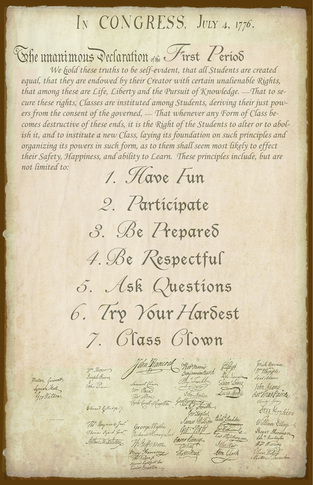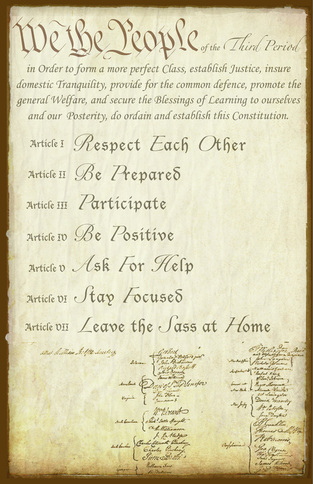Ms. Curtis & Mr. Schumann's Foundations of World History
Class Norms
During the first week of school, each Foundations class will create and vote on a class agreement. The purpose of this agreement is to establish norms that will help us achieve a consistent, high functioning, positive, and healthy learning environment. The norms that form the core of these agreements are developed and approved by students through a consensus vote. As a class, we will periodically review the agreement to decide how well we are living up to our obligations as members of the group. Below are two examples of agreements developed by our current class.
Class Rules
In addition to the class agreement, students MUST follow all school rules contained in the Sammamish Student Handbook. These rules prohibit the following actions:
- Failure to comply, in a passive way, with the lawful directions of school personnel or volunteers who are acting on behalf of the district in the performance of their duties.
- Using and/or possessing any tobacco products.
- Presence during school hours on the campus of any Bellevue school other than the school in which the student is enrolled, except when the student has first checked in at the administrative office of the school and received permission to visit. Such permission will be granted if the visit is in furtherance of the educational goals of the student or for a school district purpose.
- Harassment, intimidation and/or bullying of others.
- Profanity, obscenity, indecent and/or lewd conduct.
- Vandalism, destruction, damage, or theft of school property or the property of others that is of nominal monetary value.
- Gambling for the purpose of monetary gain.
- Possession of drug paraphernalia.
- Hazing in any form not covered by Policy 4071, except for initiation or similar activities which are expressly approved by school administrator.
- Cheating.
Consequences
Behaviors that place the learning community at a small risk, or first time unwanted behaviors that require some sort of intervention, will elicit the following responses:
- Redirect undesirable behaviors
- Offer students choice to make voluntary change
- Use of proximity prompts
- Limitation of choices (e.g., assigned groups, seating arrangements)
- Student will be told to stay after class for a one-on-one conversation. During the conservation, the student will be asked to explain the cause of the behavior.
- Student may be asked to take a time out (e.g., step out of the class or get a drink a water). The purpose of this timeout is for the student to collect him or herself and change the undesirable behavior.
- Student may be asked to attend a manadatory tutorial to discuss the behavior. If student fails to attend, a referral will be issued.
- A referral may be issued immediately.
- The students' parent(s) or guardian(s) may be contact through e-mail or a phone call. If necessary, a conference may be called involving the student, parent(s) or guardian(s), and/or a school adminstrator.


